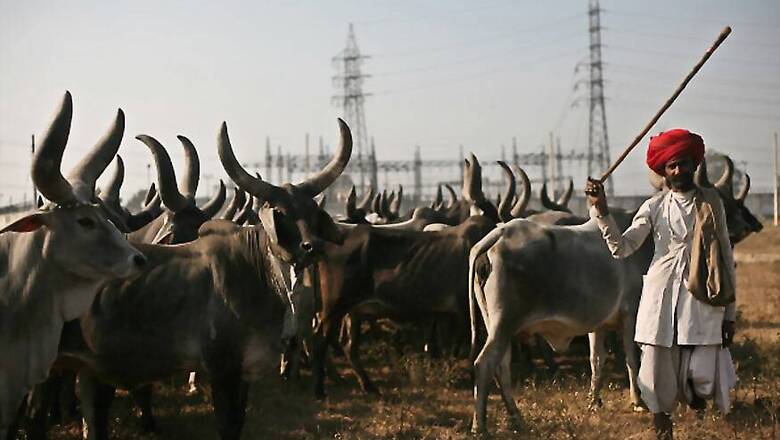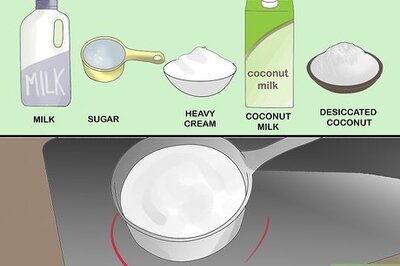
views
The cows chew contemplatively, secure inside the Border Security Force (BSF) outpost in West Bengal’s Taki town along the Ichamati river, perhaps wondering what comes next.
They have reasons to be ruminative. A cow that no longer gives milk, has little value for farmers. Bulls even less so. An estimated 30 million of them are simply being let loose every year.
This feeds a lucrative cattle-smuggling trade along the 4,000-km border India shares with Bangladesh, with trafficking particularly prolific in West Bengal and Assam.
Since coming to power, the BJP gave the BSF a clear mandate: end the smuggling of India’s ‘holy’ cows to Bangladesh that thrived along outposts, such as the one at Taki, which is part of the Basirhat sub-division in the North 24 Parganas district.
Five years later, with a major election beckoning, the crackdown on cattle slaughter across India and plugging age-old smuggler routes to Bangladesh have had an unintended, if not wholly unprecedented, result.
In 1955, the Expert Committee on the Prevention of Slaughter of Cattle had noted “what a menace wild cattle can be”, forcing “desperate” governments to “spend a considerable sum for catching (them)…to save the crops”.
That warning wasn’t paid heed to and now, across India, farmers lie awake at night desperately trying to protect their crops, schools are being broken into to shelter cows while state governments are once again spending considerable sums.
Things are different along the Ichamati too. Its ever-changing waters, the border between India and Bangladesh and inevitable muddy maps allow smugglers to prosper.
Till a few months ago, these seized cows would’ve ended up in customs auction.
But since December, the department has cited a Supreme Court order, refusing to auction the seized cattle. The police, the BSF maintains, have also been uncooperative.
“Woh bhi sochte hai, hum bhi kya karen (They also wonder what to do). We try and get NGOs or gaushalas to take them. But it’s expensive,” says a 27-year-old BSF jawan from Haryana at the outpost.
“It could be worse though. The chain of smuggling has broken. Supply is less and, surprisingly, demand in Bangladesh has also gone down. Otherwise, we’d be drowning in them, like they are everywhere else.”
The politics of cattle smuggling is visceral in Basirhat. The 70-km border of the North 24 Parganas district, 55 km of which is riverine, accounted for almost half of the total cattle smuggled through Bengal.
This also was the foundation for the BJP’s entry into the state assembly, with an acerbic campaign to “stop Bengal from becoming Afghanistan”, propelling a victory for former legislator Samik Bhattacharya.
In 2016, Prime Minister Narendra Modi urged Basirhat to “show Bengal the way out of darkness”.
That cattle smuggling has dipped is something the ruling TMC and BJP agree on today.
Bhattacharya speaks of the “breakdown of the TMC syndicate that controlled cattle smuggling due to increased awareness and decrease in supply”, while sitting Lok Sabha MP from TMC Idris Ali credits it to “people not wanting to do anything ‘wrong’ that goes against what our leader Mamata Banerjee wants”.
BSF director-general KK Sharma said in July that numbers had continually dropped since 2014, with the force seizing 1.11 lakh cattle heads across the 4,156-km border in 2017, down from 1.74 in 2016.
By January 2018, the trade had shrunk from Rs 9,000 crore to just Rs 1,600 crore, estimates the BSF.
Mohammad Moinudin, 65, knows the map and math of cattle smuggling. Once a trafficker himself, he now ferries tourists from Kolkata across the river.
“Smuggling has always been here. The border was just something for the babus on both sides to bother about. Cloth, gold or goods. But since the 90s, it was just goru (cow). Everyone was in on it and we made a living. It shaped us and the politics here,” he says.
In 1971, faced with a crippling lack of draught cattle required for cultivation due to their slaughter by a marauding Pakistani army, Bangladesh Prime Minister Sheikh Mujibur Rehman had urged his country to “drink milk…not eat cattle”.
The methods and routes of smuggling that developed then continue today. Aspects, such as Hindu handlers finding it easier to evade scrutiny, didn’t change. Others, like modifying ambulances instead of trucks to cart cattle, are recent additions.
By 1994, Bangladesh set up a number of custom corridors along the border, effectively legalising cattle smuggling. “There were no jobs then. Factories were shutting down. But a smuggler could become a legitimate trader by paying just Rs 400,” added Moinudin.
Until very recently, cattle smuggling sustained the frayed local economy. Now lives are again being recast.
Chandana Ghosh, 42, for instance, grimaces at the thought of Saraswati Puja. The clubs that would organise lavish ceremonies after extorting money from cattle smugglers, have turned to locals, she explains.
“Last Durga Puja was bad for them. Since then, each festival they are at our doors, with ever increasing chanda (subscription) amounts.”
Others like football-crazy Anarul Biswas, 27, dream of getting out. “Dubai or somewhere else. Even Kerala. There is more money to be made and you don’t risk being shot,” he says.
On the road to Kolkata, at the Bhebe Choumatha there are two small eateries.
Swadhin Hindu Hotel serves rice, daal, fish and chicken. On the other side of the road, at Salem Muslim Hotel, the menu is identical, barring the addition of beef biryani.
Lining the road are about a dozen seated cows – all that remains of a cattle haat that once saw hundreds of these bovines change hands hourly.
“No one wants to buy cows anymore because they’re scared they will be stopped on the way and branded a smuggler. Most cattle traders have moved to other work, farming or labour,” explains Shamwar Hossain, 42, a trader.
A few, like 34-year-old Dibyendu Ghosh (name changed), a cattle smuggler from Swarup Nagar, are holding out. “What else can I do? I know nothing else. Border ta ki? Ekta lok eshe bollo, eita Bangladesh, eita India. Khela naaki? (What is this border? One man came and said this is Bangladesh, this is India. Is this a game?),” he said.
Ghosh isn’t the only one who hasn’t been able to imagine the two countries as discreetly cordoned off entities.
This remained the key problem in managing the border itself, argued NS Jamwal, now the IG BSF of the Jammu Frontier.
In his 2008 essay, Border management: Dilemma of guarding the India-Bangladesh border, he argued that “negligence by the mainland” forced people with a “common history of growth, culture, language and rich heritage” to turn to “traditional systems for their survival” giving rise to “cross-border movements”.
These traditional systems relied on ‘unspoken rules’ explained Alamgir, a Bangladeshi cattle trader from Basirhat’s adjoining Sathkhira.
“Cattle smuggling isn’t immoral and forces would ignore it,” he said, over the phone. But his profits are shrinking, with Bangladesh’s urgent efforts to boost beef production in response to India’s crackdown.
By January 2018, the country was producing 71 lakh tonnes of meat against an annual requirement of 68-70 lakh tonnes and hopes to start exporting beef by 2020.
The cattle arrives at haats near Basirhat primarily from Madhya Pradesh and Uttar Pradesh via Jharkhand and Odisha. The next step is to keep the cows undetected, close to the border.
Finally, the actual crossing. “During the winters, the river and fog make it easy. But the monsoons are different and require skills. We would either prop the cow up with logs or a rakhal (a cattle herder) would swim with them and guide them,” adds Ghosh.
The BSF relied not just on traditional methods like increasing manpower and repairing fences, but also new tactics: increasing surveillance on roads leading to the border, speedboats armed with night vision devices across riverine borders and digging trenches along the borders and rivers to effectively trap cattle.
By December 2015, 21 cross-border criminals were shot dead, 16 of them cattle smugglers. In July last year, BSF director general KK Sharma admitted that with each death, Bangladesh came under “tremendous pressure” and since then, the ministry of external affairs, through the ministry of home affairs, asked the BSF to reduce the “number of killings”.
There were 10 deaths in 2017 and none till July 2018, he said.
But that, sources in West Bengal police said, is only half the story. “The smugglers are still operating. There is less movement in terms of cattle. But the rot runs deeper. Take the BSF commandant with the blue bag, for instance.”
The commandant, in question, is Jibu D Mathew, posted with the 83 Batallion at Murshidabad. In January 2018, he boarded a train to Kerala and as the train rolled into Ernakulam CBI officers boarded it and eventually arrested him at Alappuzha.
The blue bag yielded Rs 47 lakh – 22 bundles of Rs 500 and 18 bundles of Rs 2,000 notes, described by the FIR as “illegal gratification for favours” made to smugglers, and his interrogation yielded a name: Bishu Sheikh.
Many, an IPS officer posted in Kolkata said, had heard the name. But this was the first time that investigators had evidence that the shadowy kingpin of cattle smuggling wasn’t a convenient fiction.
The name, an alias for Kolkata-based Muhammad Inamul Haq, led to his arrest in February and his assets, valuing into several crores, were frozen. That is where it should have ended.
But investigators soon found out that not only did Haq control cattle-trafficking operations across north Bengal, but was also smuggling heroin into the state. How large was his network?
“Massive,” a CBI officer answered. “We just don’t know how massive.” What the CBI has learnt is that Haq evaded detection for nearly three decades.
“He never gave his real name upon arrest. He then bribed or cajoled his way out of prison and went on his business,” said the officer, adding that there is at least one case of heroin smuggling where he was arraigned and acquitted by a court in the state.
“There is a genuine fear that while the BSF has been worrying about cows, the state has been flooded by other contraband,” said the IPS officer.
Back at Taki, the cows watch as Moinudin is met by a tourist-laden rickshaw around mid-day. “Where exactly is the border?” asks a tourist. Moinudin points at the river and Bangladesh across it and says, “It’s there, somewhere in the middle.”
Eight hundred and fifty seven months after Cyril Radcliffe wrote about the problem of the “few, if any, satisfactory natural boundaries” to divide Bengal, 573 months after the birth of Bangladesh, 45 months after union home minister Rajnath Singh ordered the crackdown and weeks after schools in Uttar Pradesh housed stray cattle, the story of cattle smuggling has come a full circle.
The river, an impossible repository of sentiments and anxieties, appears not to care.


















Comments
0 comment